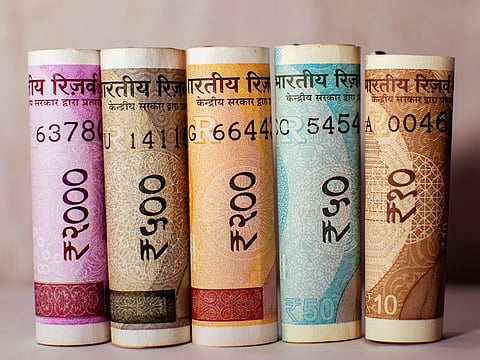At 82.80, Indian rupee wins back some strength - but another dip not too far away
Early Thursday, the AED-INR exchange hit 22.50, but is at 22.39 now

Dubai: The Indian rupee has started the day at under 83 to the dollar as India’s central bank tries to regain some of the value the currency shed in the last two days. At one point yesterday (October 21), the INR had dropped to 83.26 – the lowest point to date - before regaining some ground to close trading at 82.75.
This morning, the rupee is at 82.80, but still shaky enough to plunge back well below 83. On the currency exchange front, “the AED-INR was going for 22.50/22.54 yesterday morning and those Indian expats who had spare cash made good on the rupee weakness,” said an FX analyst. “But anything around the 22.40 levels would still be good as the remittance period starts from late next week.
Early on Friday, the AED-INR is at 22.42.
“In each of these last three months, UAE Indian expats have benefitted from fresh triggers that caused the rupee to head to new lows.”
And a lot happened between October 7 and now, with the rupee slipping past 22 to the dirham on October 7 and then crashing to 83 against the dollar on October 19 afternoon. “The way things are with a strong dollar, it would not be a surprise to have the INR hit 84 before year-end.
“In the past, the rupee would typically slide by 1-1.5 per cent on average annually. But not this year, with the currency falling by more than 12 per cent. These are exceptional times.”
On January 12, the INR was at 73.81.
RBI and the rupee
Before the latest rupee weakness, the Indian central bank had upwards of $550 billion in dollar reserves. The RBI had already used up a significant portion to arrest the currency slide since summer. "Through this year, RBI intervention in the forward markets to ensure enough liquidity in rupee reduced the interest rate differentials with the US, making the INR less attractive from a 'carry trade' perspective," said Bal Kishen Rathore, CEO of Century Financial. "To put it simply, the spread between Indian and US interest rates is quite narrow as the Federal Reserve is aggressive in hiking the interest rates while RBI is more on the neutral side from a monetary policy perspective. This means risk-free US dollar assets are giving sufficient returns giving foreigners less incentive to invest in Indian bonds. "This reduced dollar inflows and hurt the rupee. RBI is likely to be cautious regarding interventions in the currency market, having (already) spent $100 billion to defend the currency. As a result, the near future of the rupee is forecast to remain gloomy and could slide to 83.50."
Sign up for the Daily Briefing
Get the latest news and updates straight to your inbox



